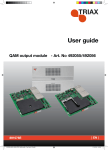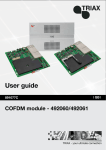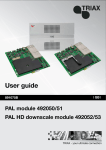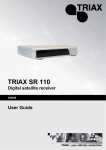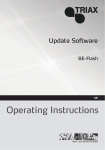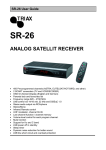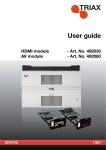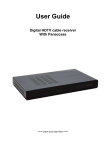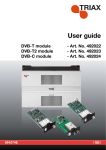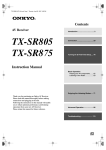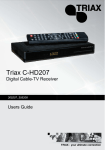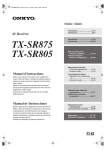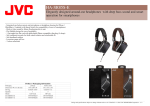Download User guide
Transcript
User guide IP output module 891080A - Art. No. 492072 | GB | Contents Contents Disposal.................................................................................................................................. 3 Box content ............................................................................................................................ 3 IP output module ................................................................................................................... 3 Labels ..................................................................................................................................... 4 Installation of IP modules ..................................................................................................... 5 Installation of extender boards ............................................................................................ 6 Installation of SFP receivers ................................................................................................ 7 Module removal ..................................................................................................................... 8 CAM/Smart card .................................................................................................................... 8 Status LED ............................................................................................................................. 9 Network switch...................................................................................................................... 9 Log in .................................................................................................................................... 10 Administration window ....................................................................................................... 11 CA Modules window ........................................................................................................... 14 CA Modules configuration window .................................................................................... 15 Status information.............................................................................................................. 21 Output window .................................................................................................................... 22 Configuration of IP module ................................................................................................ 23 Status information ............................................................................................................. 27 Delete output module ........................................................................................................ 29 IP output - EIT ...................................................................................................................... 30 Save configuration .............................................................................................................. 33 Technical data ...................................................................................................................... 34 Manufacturer ....................................................................................................................... 36 2 Introduction Disposal Within in the European Union this label indicates that the product cannot be disposed of with the general household waste. Neither the headend nor the input and output modules can be disposed of with the general household waste. For proper treatment and recycling of old products, please take them to designated collection points in accordance with your national legislation. Box content A new output module is wrapped in antistatic bubble wrap and packed in a cardboard box when you receive it. Included in the box is an IP output module, an auxiliary board, an SFP transceiver and a user guide instructing you in how to use the TDX Service Tool to configure the module. IP output module The IP output module is an output module for transmission of digital video, audio and miscellaneous data, encapsulated within one or more MPEG2/ DVB single program transport streams. You install the IP output module in the output section of your TDX headend unit. The TDX headend system offers you the following possibilities when you distribute IP services through the AUX sockets using IP output modules: UÊ UÊ UÊ UÊ UÊ UÊ UÊ UÊ IP multicast streaming UDP streaming RTP option IGMP version 2 SPTS including SDT, PAT, PMT, CAT Packet ratio of 3-7 TS packet per IP packet - ratio 3-7:1 Max. BW 720 Mbits/s 96 services on each IP output module/AUX socket Important To distribute IP services using IP output modules in the TDX headend system you have to buy licences for IP output from Triax and activate the licences using Licence handling in the Administration window. See the user guide of the TDX Headend Unit regarding how to get IP licences. 3 Basics Below you can see an illustrated description of a IP module with CI slots and an auxiliary board. Labels A label is placed on the module where you can write the information regarding the configuration of the module. Besides the information that you write on the label, the module type and part number are also displayed on the label. Note The coloured part of the label informs you of the module type. Each type of module is allocated a unique coloured label. On the bottom of the module you will find a label with the bar code and a serial number printed on it. An auxiliary board is labelled “AUX-TS loop”. 4 Basics Installation of IP modules You can only install two IP output modules in each TDX headend unit, and you have to install them in slot no. 3 and 6 in the output section of each unit. Note In the following illustrations the extractor fan has been removed from the output section to facilitate the explanation of the installation. It is not necessary to remove it when you install the modules. You install an IP module by sliding the module into slot no. 3 or 6 in the lower section of the headend unit, and click it into place. IP output module in slot no. 3 Note IP output module in slot no. 6 You can use hot swapping when you insert a module into or remove a module from the TDX system. 5 Basics Installation of You can only use an IP output module in connection with an auxiliary board. auxiliary boards When you have installed your IP output module you install the auxiliary board in the auxiliary board area, by sliding the board into the required slot. Slot no. 2 Slot no. 1 Auxiliary board area There are two slots in the auxiliary board area, slot no. 1 and slot no. 2. The slot position of the auxiliary board depends on the slot position of the IP output module: IP output module in slot no. 3 Auxiliary board in slot no. 1 IP output module in slot no. 6 Auxiliary board in slot no. 2 Slide the auxiliary board into slot no. 2 IP output module in slot no. 6 6 Basics Installation of SFP receivers You use the AUX sockets on the headend units to distribute IP services using the IP output module. Before you can connect cables to the AUX sockets you have to insert SFP copper or SFP fibre-optic transceivers into the AUX sockets. Which AUX socket you have to use depends on the slot position of the IP output module: IP output module in slot no. 3 AUX socket 2 IP output module in slot no. 6 AUX socket 1 SFP tranceiver (and cable) in AUX socket no. 1 Auxiliary board in slot no. 2 IP output module in slot no. 6 7 Basics Module removal You release an output module from a slot by using the lock mechanism that is placed to the right of the modules in the output section. Move the lock mechanism slightly to release the module. CAM/Smart card You can insert 2 Conditional Access modules (CA) into each IP module. Each CA module is able to descramble at least one or more services. Which services depend on the service provider of the CA module and smart card. 8 Basics Status LED There is a status LED on the front of each module. The LED indicates whether the module functions according to its purpose or fails. Green - flashing The IP module receives data. Green - constant on The IP module receives valid services. Red When starting the TDX system the IP module and the system controller negotiate connection speed. If the LED continues to be red either the IP module or the system controller has not been inserted correctly. No colour The IP module has not been configured yet or the module has not been inserted correctly. When you update the software of a module the status LED provides you with information about the updating process. Network switch Orange Boot loader state. Temporary off Initiation of the software update. Temporary green Every time the modules receives a valid data package. Repeated until the update is completed without errors. Red Software update failed. When you want to use the TDX headend system to deliver IP services using IP output modules you must connect the main unit and subunits to a Gigabit network switch. For each unit that has an IP output module installed, you will need to connect AUX 1 and/or AUX 2 to your network switch. Use Cat 5e shielded or better cables for these connections. Main unit Subunit 1 Subunit 2 2 IP output modules are installed in each unit and connected to a network switch through AUX 1 and 2 on each unit 9 TDX Service Tool Log in When you have loaded the TDX Service Tool from the TDX headend system to your laptop/computer the Login window of TDX Service Tool is displayed. 1. Enter your password 2. Click the Log in button When you have pressed the Log in button the System window is displayed. 10 TDX Service Tool Administration window To output services using an IP output module you may have to open the Administration window and the IP settings area so you can enter an IP address and subnet mask for each AUX socket you use on the headend system. Click the Admin. button to open the Administration window. To enter the IP settings area, click the arrow bracket to the left of IP settings. 11 Settings Click the Enter setup button to open the IP settings window To open the IP settings window, click the Enter setup button. 12 Settings When you use the AUX sockets for distributing IP services your headend system must be connected to a network using an internet switch. Select the Switch radio button if it is not selected when you display the IP settings window. to enable all the Link and AUX fields your TDX headend system uses. Enter new IP addresses and subnet masks in the AUX fields you want to use but be careful not use addresses that have been used elsewhere. Enter addresses and subnet masks that you use in your headend system When you have made the changes you want to make in the IP settings window, click the OK button at the bottom of the window to return to the Administration window. Now click the OK button at the bottom of the Administration window to save the changes and return to the System window. 13 TDX Service Tool CA Modules window Click the CA Modules tab in the TDX Service Tool to display the CA Modules window. The first time you display the CA Modules window in a new configuration the module list only displays the number and type of the CA modules that you have inserted in the main and subunits. You have to configure the CA modules individually. To display the Configuration window, click the Setup button of the CA module you want to configure. 14 TDX Service Tool CA Modules con- The first time the TDX Service Tool displays the Configuration window for a figuration window CA module in a new configuration the fields and radio buttons display default values and nothing is selected in the service list area. Card speed If your smart card is able to use a higher card speed than the default card speed, open the drop-down list with the card speeds you can choose from. Select the card speed you want to use. 15 TDX Service Tool Card function You can use the Card function radio buttons to determine whether you want the CA module to descramble services that are scrambled or you want the module to scramble services that are not scrambled . Click the Descramble (default) button if you want to descramble services . Click the Scramble (PanAccess) button if you want to scramble services using the PanAccess Scrambler. In the Service list area you can select the service or services that you want to descramble and you can set up individual filter options for each service. The services that are scrambled are marked with a dollar sign - $. 16 TDX Service Tool To select a service, click the check box (square) to the right of the service in question. If you want to change the filter options for a service, click the Setup button of the service in question to open the Filter options window. The first time you open the Filter options window the default value Descramble all audio PIDs has been selected. 17 TDX Service Tool If you want to descramble PIDs (Packet Identifier) that are not audio or video PIDs, click the Descramble non audio/video PIDs check box. In case you do not want to descramble all audio PIDs you can select which audio PIDs you want to descramble. To descramble only selected audio PIDs you have to deselect the Descramble all audio PIDs check box. When you have deselected the Descramble all audio PIDs check box a field with a drop-down list is displayed below the check box. To select which audio PID you want to descramble, open the drop-down list with the languages you can choose from. 18 TDX Service Tool Select the language of the audio PID you want to descramble. When you have selected the required language, a second field is displayed below the first field so you can descramble another audio PID. You can descramble as many audio PIDs as you need. If the language of the audio PID you want to descramble is not displayed in the list you can enter a three letter string signifying the language you need. To remove your selection leave the field empty. Click OK to return to the Configuration window. When you have selected the services you want to descramble and changed the filter options you want to change, you have to click the Submit button to save this information in the headend system and return to the CA Modules window. 19 TDX Service Tool You use the Common interface button to open the common interface menu. Clicking the Common interface button gives you access to information from the smart card inserted in the CA module. The type of information provided by the smart card depends on the card itself and its make. Below is an example of the interface of a Conax card. Please refer to the user guides of the CA modules and smart cards you have inserted in the output modules for further information. If you need to reboot the CA module you can use the Reset CAM button. Click the Reset CAM button to reboot the TDX headend system. 20 TDX Service Tool When you have selected the services you want to descramble or scramble you have to click the Submit button to enter this information into the headend system and return to the CA Modules window. When you return to the CA Modules window the descrambled services will be displayed next to the CA module you have configured. Remember to click the Apply button in the upper right-hand corner to save new settings in the configuration. Status information To be implemented later. 21 TDX Service Tool Output window Click the Output tab in the TDX Service Tool to display the Output window. You can only install two IP output modules in each TDX headend unit, and you have to install them in slot no. 3 and 6 in the output section of each unit. According to the illustration above, an IP output module has been installed in slot no. 3 in the main unit. Note You can divide the output of your services into four priorities. To configure the IP output module, click the Setup button to display the Configuration window Click the Setup button 22 TDX Service Tool Configuration of IP module The first time the TDX Service Tool displays the Configuration window in a new configuration the fields in the window will either display a default value or be empty. IP packet ratio To select the desired IP packet size, click the arrow to the right of the IP packet ratio field to open the dropdown list with the packet ratios you can choose from. Select the ratio you want to use. In the combination area you create configuration lines. In each line you enter an IP addresses and select a service. IP address Enter a multicast IP address between 224.0.0.0 and 239.255.255.255 in the IP address field. Note Be careful that your multicast addresses do not collide with the multicast addresses that the TDX headend system utilises for internal use. Select IP packet ratio Enter IP address and port number 23 TDX Service Tool Port Enter the desired IP port number in the Port field. RTP If you want to enable Real-Time Transport Protocol (RTP), click the RTP check box. Setup To select services, click the Setup button to open the Select services window. Click the Setup button The Select Services window displays all the services that are available from the TDX pool. f 24 TDX Service Tool In the Select Services window you can select the service that you want to output. Note You can only select one service per IP address. To select a service, click the check box (square) to the right of the service you require. 1. Click a check box to select a service 2. Click OK to save and leave the window Click OK to return to the Configuration window when you have selected the services you want to output. line has been added in the combination area In the Configuration window a new empty configuration line has been added in the combination area. 25 TDX Service Tool Now you can continue to enter more IP addresses and select more services to output using the AUX sockets. The service you have selected to output on one IP address will Note no longer be available in the TDX-pool for the configuration of other IP addresses in the TDX headend system. . You can output 96 services on each IP output module. You can output all your IP services as priority 1 services or you can output some of them as priority 2, 3 or 4. If you want to delete one of the configuration lines (IP address, port number and service) in the combination area, click the Delete button of the configuration you want to remove.. Click the Delete button to remove a 26 TDX Service Tool If you have selected more services than your licence(s) entitles you to select, you will get a warning and the services that exceed the number of services you can select will be deselected Status information Status information is placed at the bottom of the Configuration window. The information displayed in the configuration window includes RTP protocol and services. Information Status Tells you whether any errors have been detected. SW-Revision Displays the software version of the output module. TX BitRate (Min/Max) Tells you the minimum/maximum load of megabyte (MB) on the AUX socket. TX BitRate (Cur/Avg) Tells you the current/average load of megabyte (MB) on the AUX socket. 27 TDX Service Tool When you have selected the services you want, click the Submit button to enter the information into the TDX system and return to the Output window. Click the Submit button to save your selections Note When you display the configuration window for an IP output that has been configured, all fields are filled in and service(s) have been selected. If you want to change the existing IP address, port number and services, just follow the same procedure as when you configure an IP output for the very first time. When you have made the changes, click the Submit button to enter the information into the TDX system and return to the IP Outputs window. When you return to the Output window, the configuration of the IP output module is displayed in the list. The IP output module 28 TDX Service Tool Remember to click the Apply button in the upper right-hand corner of the TDX Service Tool to save any changes in the configuration. Delete output module If you want to remove an output module and the associated configuration, you can use the Delete button of the module in question in the Output window. Click the Delete button of the IP output module you want to remove. A message window is displayed asking you to confirm that you want to remove the output module. Until you have removed the output module physically from the headend unit, the module list will display four lines with the writing in red. been deleted 29 TDX Service Tool IP output - EIT A barker channel carries all EIT information (Event Information Table) for a number of services. It is possible to use an EIT barker channel to carry all EIT information for your IP output. The EIT barker channel can be output in two ways depending on how you distribute your IP output. UÊ If you distribute your IP output through the Link sockets, then the EIT barker channel is output using Link 2 on the main unit. UÊ If you distribute your IP output through an IP output module, then the EIT barker channel is output using the AUX socket of the first IP output module in the TDX headend system. Before you can use a barker channel for distributing the EIT information, you have to configure the channel using the Network tab. Click the Network tab in the TDX Service Tool to display the Network window. Click the Network tab to display the Network window It is in the “IP settings” area in the Network window that you configure the barker channel for your IP output. 30 TDX Service Tool In this area you barker channel for your IP output Use EIT barker for IP out Click this check box to enable the barker channel for IP output. EIT barker IP address Enter the desired IP address for the EIT barker channel in this field. EIT barker IP port Enter the desired IP port number for the EIT barker channel in this field. Click the check box to enable the barker channel Enter IP address Enter port number 31 TDX Service Tool Then click the Submit button to enter the configuration into the TDX headend system. A message window is displayed confirming that the configuration has been submitted to the TDX system. Remember to click the Apply button in the upper right-hand corner of the TDX Service Tool to save your configuration of the barker channel in the system configuration. The next time you display the Network window a single line of information will be displayed below the EIT barker IP port field in the IP settings area, telling you which unit and socket the EIT barker channel uses. Information about which unit and socket the EIT barker channel uses Important When you configure the barker channel be careful not to use one of the IP addresses that you have used for distributting services. 32 Manufacturer Save configuration An important button when you change your configuration of the headend system is the Apply button placed in the upper right-hand corner of the TDX Service Tool window. Click the Apply button to save the changes Apply Whenever you have made changes in your configuration, “Apply” on the Apply button turns red to tell you that you have unsaved changes that need to be saved. Click the Apply button to save the changes. When changes have been saved the “Apply” text looses the red colour. 33 Technical data Technical data IP output module Product Art. No. 492072 IP input Type TDX BE proprietary control and data Connector PCIe x1 edge connector Maximum input bandwidth 720 Mbit/s Data format Proprietary TDX MPEG2/DVB SPTSs UDP/IP via GbE Output TDX BE proprietary control and data Type Connector PCIe x1 edge connector RF connector type F-connector Maximum total bandwidth 720 Mbit/s Maximum peak bandwidth 940 Mbit/s Output format 0-96 x MPEF2/DVB compliant VBR SPTS Output protocol UDP/IP multicast via GbE 3-7:1 TS / IP packet ratio (configurable via GUI) RTP (optional via GUI) Output SPTS priority 1-4 (configurable via GUI for each SPTS EIT No EIT - must be obtained via native IP OUT Power supply V/mA 12 / <600 Temperature, operating °C -10…+50 Temperature, storage °C -20…+70 Humidity, operating % 20...80 Humidity, storage % 10...90 Voltage/current Environment Mechanical data Dimensions, product mm 162 x 180 x 12 (21 CI) Dimensions, Triax carton mm 183 x 266 x 55 Weight, net/gross g Connector 215/305 PCIe x1 edge connector RF connector type F-connector 34 Your notes 35 Manufacturer Dear Customer, Should you require technical assistance in the event that your expert dealer is unable to help you, please contact us at: Triax A/S Bjørnkærvej 3 8783 Hornsyld Denmark DECLARATION OF CONFORMITY TRIAX confirms that the product conforms to relevant EEC harmonised standards and consequently can carry the CE-mark. Relevant harmonised standards: DE/EN 60728-2 2010, DS/EN 60728-11 2010 and DS/EN 50083-2 2006 This document is only valid with the signature of the person responsible for CE-marking by Triax Date: October 2012 06 - 2013 Signature:




































